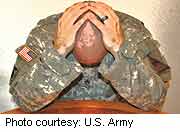
FRIDAY, June 25 (HealthDay News) — At first, Darisse Smith tried to shake off the throbbing in her back and leg. An Army captain, helicopter pilot and triathlete, she was used to pushing herself physically and mentally.
But as her Iraq deployment continued, the pain grew more intense, until it felt like she was being stabbed. She could hardly sit, stand or walk, let alone fly, and was eventually medically discharged.
The next two years were a blur of pain medications and surgeries. “It was a rough time,” Smith said. “At home I would not want to talk to anybody. My husband saw me withering away.”
Finally, with the help of doctors at Southeast Pain Care in Charlotte, N.C., and an implanted spinal cord stimulator, Smith improved substantially. She has also become a pain advocate for the American Pain Foundation, helping to raise awareness about the complex conditions facing veterans and encouraging them to seek help if they’re experiencing pain.
“There’s an attitude in the military that you have to ‘tough it out,’ but that’s not true,” Smith said. “No one should have to live in pain.”
Many vets, however, seem to be doing just that. About nine in 10 Iraq and Afghanistan veterans who registered for care with the Department of Veterans Affairs are experiencing pain, and more than half have significant pain, according to a study presented in May at the American Pain Society’s annual meeting. Significant pain is a 4 or greater on a scale of 1 to 10.
Sources of pain include combat injuries, including burns and post-amputation, said lead study author Michael Clark, clinical director of the VA’s Chronic Pain Rehabilitation Program in Tampa.
Exposure to multiple, powerful blasts can also leave vets with pain, Clark said. Even if they’re not hit by shrapnel or debris, blasts create powerful pressure waves that can be strong enough to throw those in proximity to the ground or into buildings, Clark explained.
It’s believed that the cumulative exposure to those sudden surges in pressure may damage central nervous system tissues, leading to headaches and thinking difficulties, among other symptoms, Clark said.
Often, pain conditions are worsened by other post-deployment problems, such as post-traumatic stress disorder or traumatic brain injury. Both make treatment more difficult, Clark said.
“These conditions are interacting and creating more challenges for the folks that are returning,” Clark said. “They are complicated problems that can involve cognitive issues, emotional impacts, and acute and chronic pain. For some, it may resolve in a few months. But for others, it may never resolve and will be there for the rest of their lives.”
With 90 percent of those who are injured in battle surviving — compared to 40 percent during the Vietnam War — vets are coming home with complex conditions that require extensive need for rehabilitation and pain management. “People with these levels of injuries were not surviving before,” Clark said.
About half of returning vets register for care with the VA, Clark said. The study included 239 vets being seen at two VA hospitals in Minneapolis.
It’s not just combat injuries that are leaving vets plagued by pain. The everyday rigors of the job — heavy lifting, marching while carrying 80-pound backpacks or jumping out of trucks or planes — can lead to or exacerbate back injuries, joint pain from conditions such as arthritis and muscular skeletal pain, Clark said.
About 25 percent of vets had some form of pain even before deployment, a higher percentage than during previous conflicts because many of today’s troops are Reservists and National Guard soldiers who tend to be older, Clark said.
When pain is treated early and aggressively, patients have the best chance of getting better, he added. Though many fear addiction from opioids, they can be an important part of halting the pain cycle. “We think it’s extremely important in terms of their future to intervene as soon and as strongly as possible,” Clark said.
Now 32, Smith was devastated when she had to give up flying. But, making the best of things, she works in customer service for a cell phone company and has taken up martial arts.
“It’s something I’ve learned to adapt my life to,” Smith said. “I’m not going to be able to be as active as I used to be, but I’m always looking for things I can do.”
As a pain advocate, she wants to encourage vets and those in the military to seek care when needed, to understand being in pain is not a sign of weakness and to be persistent.
“When you’re in that kind of pain, it’s a daily hell,” Smith said. “You have things you want to do, goals and dreams. Most people want to be able to work, go for walks, enjoy playing with their children. When you are in significant pain, you are robbed of those life experiences. All you can focus on is the pain and how miserable you are,” she explained.
“It takes a very strong person even to try to get help,” Smith added. “It’s that overwhelming.”
More information
The American Pain Foundation has more on vets and pain and where to get help.

